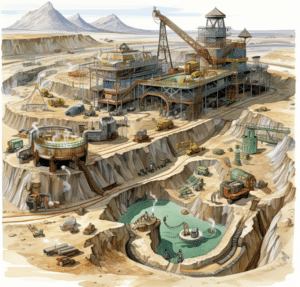Introduction – Carbon Negative Diamonds
Diamonds, with their irresistible sparkle and timeless charm, occupies a special place in our hearts. Lately, a striking development in the jewelry industry ensures that these precious gems no longer come with an environmental cost. Emerging to the forefront are carbon negative diamonds, a symbol of the harmonious blend of beauty and sustainability.

Diamond Use: Industrial And Personal
Diamonds, with their unmatched sparkle and durability, have long held a special place in both the industrial and luxury markets. As we delve into the evolving landscape of sustainable diamond production, it’s important to understand that diamonds serve two primary sectors: industrial applications and luxury jewelry.
Industrial Applications of Diamonds
In the industrial sector, diamonds are prized for their hardness and thermal conductivity, making them ideal for a variety of applications. From cutting tools in manufacturing to components in high-precision instruments and electronics, industrial diamonds are integral to numerous technologies and industries. Companies focusing on this sector are often involved in producing diamonds that meet specific technical requirements for industrial use.
Luxury Jewelry Market
On the other end of the spectrum lies the luxury jewelry market, where diamonds are synonymous with elegance and timeless beauty. In this domain, the focus is on the aesthetic qualities of diamonds, such as cut, clarity, color, and carat weight. Companies catering to this market specialize in creating fine jewelry pieces, emphasizing craftsmanship, design, and the ethical sourcing of diamonds.
Decoding Carbon Negative Diamonds
Recent advancements have added a new dimension to their allure: environmental responsibility. Carbon negative diamonds, scientifically identical to traditionally mined ones, offer an eco-friendly alternative without sacrificing the charm and quality that diamonds are known for.
Unlike their earth-dug counterparts, these lab-grown gems are produced in a way that actively reduces the amount of carbon dioxide in the atmosphere, making them a guilt-free choice for environmentally conscious consumers.
The Carbon Footprint of Traditional Diamonds
While the allure of diamonds has been timeless, the traditional methods of sourcing these gems have raised significant environmental concerns.
Understanding why traditional diamonds are considered carbon positive is crucial in appreciating the innovation behind carbon negative diamonds.
Energy Intensive Mining Processes
The journey of a traditional diamond from deep within the Earth to a piece of jewelry is energy-intensive. The mining process involves extensive use of heavy machinery, excavation equipment, and transportation, all of which predominantly rely on fossil fuels.
The burning of these fuels releases a substantial amount of carbon dioxide, a major greenhouse gas, into the atmosphere, contributing to global warming.
Environmental and Land Impact
Diamond mining often leads to significant environmental degradation. Open-pit and underground mining techniques lead to large-scale earth removal, drastically altering landscapes and disrupting local ecosystems.

This environmental impact extends beyond the immediate area of the mines, affecting surrounding natural habitats. The removal of vegetation for mining operations also diminishes the Earth’s natural ability to absorb carbon dioxide, further exacerbating the carbon footprint.
Industrial Processing and Energy Use
Post-mining, diamonds undergo several industrial processes, including cutting, polishing, and grading, each requiring additional energy and resources.
These stages often rely on electricity generated from fossil fuels, adding to the carbon emissions associated with each diamond. The cumulative effect of these processes contributes to the overall carbon positive nature of traditional diamonds.
Technology Behind the Creation of Carbon Negative Diamonds
The production of carbon negative diamonds represents a remarkable fusion of technology and sustainability. At the core of this process are advanced carbon capture techniques and the use of renewable energy.
Specialized labs replicate the natural conditions under which diamonds form, but instead of extracting these gems from the earth, they create them from carbon-rich gases. These gases are often sourced from industrial byproducts, turning potential pollutants into precious stones.
The key difference from traditional mining is the significantly lower environmental impact. Renewable energy sources like solar or wind power are used to fuel these processes, further reducing the ecological footprint.
Environmental Benefits
One of the most significant advantages of carbon negative diamonds is their positive impact on the environment. For each carat produced, more carbon is removed from the atmosphere than is emitted, making them a net positive for the planet.
This not only helps in mitigating the effects of climate change but also sets a new standard in sustainable luxury. By choosing these diamonds, consumers are directly contributing to a decrease in greenhouse gas concentrations, helping pave the way for a cleaner, greener future.
Challenges and Limitations
Despite their benefits, the production of carbon negative diamonds is not without challenges. One of the primary concerns is scalability – ensuring that these methods can meet global demand without compromising on environmental benefits.
Additionally, there are technical hurdles related to the consistency and quality of the diamonds produced, although advancements are continually being made.
Compared to traditional mining, which has its own significant environmental and ethical issues, the challenges facing carbon negative diamonds seem surmountable, especially with ongoing research and technological development.
Why Should You Opt for Carbon Negative Diamonds?
Eyeing a shift towards sustainability, choosing carbon negative diamonds over conventional ones can significantly reduce the environmental impact.
Thanks to their lab-growing procedure, these diamonds not only possess intrinsically identical characteristics to mined diamonds, but they also contribute to downsizing greenhouse gases’ presence in the environment.
Furthermore, offering a blend of quality and affordability, they come at a surpisingly reasonable price bracket, yielding better economic value for diamond lovers.
Unveiling Trailblazing Brands
The journey towards sustainable luxury jewellery wouldn’t have been possible without industry pioneers like Diamond Foundry and Aether Diamonds.
Diamond Foundry – Industrial Diamonds
Diamond Foundry is a pioneering company in the field of lab-grown industrial diamonds. Founded by engineers from M.I.T., Stanford, and Princeton, Diamond Foundry is known for its innovation in crystallizing greenhouse gases into diamonds using zero-emission energy.
Their approach is grounded in pushing the boundaries of science and technology to create diamonds that are both environmentally responsible and of high quality.
Aether Diamonds – Luxury Jewelry Diamonds
Aether Diamonds presents itself as the world’s first carbon capture diamond company, introducing a sustainable approach to fine jewelry.
They are renowned for crafting diamonds by extracting CO2 directly from the atmosphere, thereby creating pieces that are not just luxurious but also environmentally beneficial. Aether Diamonds emphasizes unparalleled traceability, ensuring that every atom of carbon in their diamonds is meticulously tracked from initial capture to final sale.
The company holds the distinction of being the first and only B Corp certified diamond company, highlighting their commitment to high environmental and social standards.
Sample Product: The Bombé Double Octo Stud Ring is a notable example of Aether Diamonds’ craftsmanship. Priced at $3,200.00 and made to order, this piece encapsulates the brand’s dedication to creating elegant and sustainable jewelry.
Each ring is crafted with precision and passion, using striking carbon capture diamonds, which make a real impact in terms of sustainability and style.
Certifying Authenticity
Identifying authentic carbon negative diamonds might be challenging for some, but genuine products carry certifications. These documents entail crucial information about the diamond, including its origin, cut, color, and clarity, along with its environmental impact. Understanding and trusting these assurances form a valuable aspect of your purchase journey.
Shopping for Carbon Negative Diamonds
You can browse and shop for carbon negative diamonds conveniently from the online platforms of Diamond Foundry and Aether. Each provides an array of cuts, colours, clarity grades, and sizes. Keep in mind to ensure that your final pick adheres to the eco-friendly claims of the chosen brand.
The Road Ahead for Carbon Negative Diamonds
Given the increasing concerns regarding environmental sustainability, carbon negative diamonds’ allure is predicted to surge. Envisioning a new norm for luxury, these diamonds became a beacon of hope for industry-wide sustainable operations, consequently revolutionizing our perception of extravagance.
Conclusion – Carbon Negative Diamonds
When one opts for carbon negative diamonds, it’s not merely an appreciation for the studded beauty; it’s a conscious and monumental leap towards environmental responsibility clothed in luxury. Affirming a commitment to love without costing the earth, carbon negative diamonds reflect a stride towards a sustainable future.
